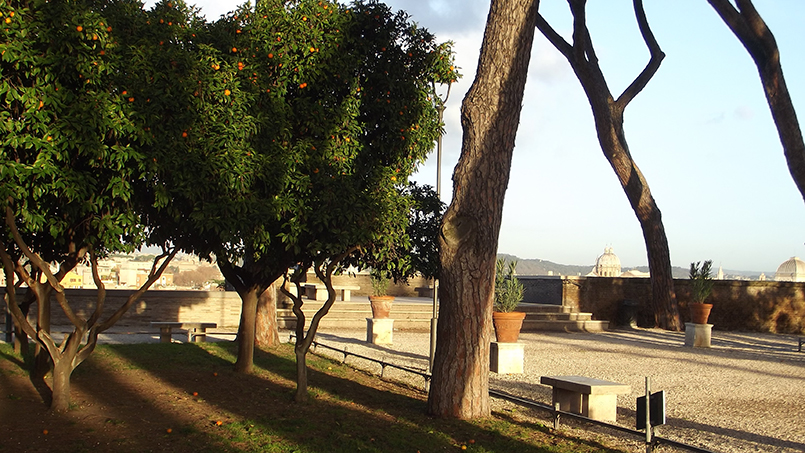Friday 24 February 2023 10:02
Aventine Hill: more to see beyond Giardino degli Aranci
Parco Savello, AKA Giardino degli Aranci/The Orange Garden, is on every traveller’s must-see list now. This little park on top of the Aventine Hill used to be one of central Rome’s best kept secrets, but since the end of the Covid emergency it has become popular and is now crowded even in shoulder season. The […]
read the news on From Home to Rome

Parco Savello, AKA Giardino degli Aranci/The Orange Garden, is on every traveller’s must-see list now. This little park on top of the Aventine Hill used to be one of central Rome’s best kept secrets, but since the end of the Covid emergency it has become popular and is now crowded even in shoulder season. The reason cannot just be its stunning view on Trastevere and the Altar of the Fatherland: certainly, influencers and travel bloggers alike must have focused on it because it’s in a quieter part of the city or because it’s one of the vantage points closest to the usual tourist route. Either way, if you’re thinking about exploring it, we’re here to tell you that you will find so much more to visit on top of the Aventine Hill. Here are the main landmarks there!
If you mean to start your “ascent” to the top of the Aventine Hill from the Circus Maximus area, don’t forget the Roseto Comunale! This small garden is open from the end of April to October, when its stunning collection of roses is in bloom. If you’re traveling with a loved one, look for the heart-shaped trellis in it and take your selfie there! We’ve delved deeper into the history of the Roseto
here
.The Aventine must be Rome’s most romantic hill. A bold claim, but hear us out: on top of the lovely gardens around these parts, the churches here are routinely used as a backdrop for weddings for couples from around the world. Santa Prisca is one of such places. If it looks different from other churches you are familiar with, it’s because it’s built on what used to me a Roman domus, so it’s floorplan is a little… odd. The underground levels of the church include a Mithraeum that is occasionally opened to the public.
Where: Via di Santa Prisca, 11
The hill’s best-known church is also one of the oldest basilicas in Rome, as it has been used continuously since 422-432 CE. Its rectangular plan has not changed in a substantial way since then, so when you visit the feeling is like having stepped back in time: you can distinctly imagine when Saint Peter’s looked like this, or Santa Maria in Trastevere, or Santa Maria Maggiore. The home of St. Thomas Aquinas when he stayed in Rome, or St. Dominic, this ancient building is mostly visited for its massive cypress doors, the oldest of their kind in Rome (if not Europe!). Trivia time: when you find the aforementioned doors, you’ll see a literal hole in the wall through which you can see an orange tree in the garden of the adjonining convent: planted by St. Dominic himself, it’s the oldest tree in Rome.
Where: Piazza Pietro D’Illiria, 1
Speaking of oranges, the Aventine Hill’s most famous landmark (… or is it? Read on!) is one of the most unassuming ones. The Orange Garden was planned in 1932 to offer Romans a breathtaking view on some of the city’s best known landmarks, and owes its name to a fortress owned by the Savelli family, who used to reign over Rome in the Middle Ages. The fortress was later included in the Santa Sabina church and monastery – that’s where the orange trees come from!
Where: Piazza Pietro D’Illiria (across the entrance to Santa Sabina)
More churches are on the Aventine Hill, some of them as famous as Santa Sabina and, once again, a backdrop to some stunning weddings. This church is mostly known for the Madonna di sant’Alessio icon, thought to have been painted by St. Luke the Evangelist, and brought to Rome by Sant’Alessio (Saint Alexius). In the underground crypt are the relics to Thomas Becket (as in St. Thomas of Canterbury). As with other churches in the area, this basilica once had a monastery, which now belongs to the Italian state.
Where: Piazza di Sant’Alessio, 23
The detail about the former monastery being transferred to the Italian state isn’t a minor one – the government created a second public park, very similar to Giardino degli Aranci, right between Santa Sabina and Sant’Alessio. It shares with the nearby Orange Garden the same views over Trastevere, but it is less crowded. The very noticeable statue of St. Joan of Arc was donated by French artist Maxime Real Del Sarte to the city of Rome in 1954, while the small ancient fountain was moved here from the Vatican area, where it decorated the
now lost
Palazzo Accoramboni.Where: Via di Sant’Alessio
Finally, here’s what everyone is queueing for when visiting the Aventine: not a building, not a statue but a… keyhole, one that famously allows you to see the dome of St. Peter’s Basilica even from this location across the city center. The doors the keyhole is part of technically belong to the Chiesa di Santa Maria del Priorato, which in turn is owned by the religious/military order of the Knights of Malta. Behind the doors are the church’s magnificent gardens, which are off limits to the the general public. You can get a glimpse of those from looking through the keyhole itself, but the main attraction here is the magnificent dome on the horizon!
Where: Piazza dei Cavalieri di Malta
